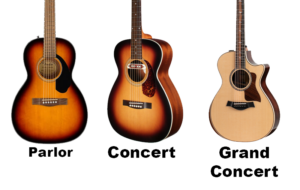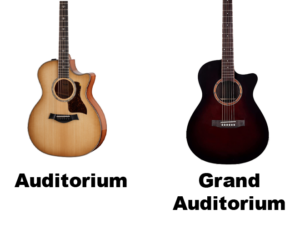Uncategorized
Guitar Tips: Unlocking Your Musical Journey
Embarking on a musical adventure with the guitar is like opening the door to a world of melodies, rhythms, and harmonies waiting to be explored. Whether you’re a beginner strumming your first chords or an intermediate player looking to refine your skills, a handful of guitar tips can make a significant difference in your journey. In this article, we’ll share valuable guitar tips to help you navigate the path of learning, practicing, and playing. Get ready to unlock your full potential and elevate your guitar-playing experience!
1. Start with the Basics:
Every guitarist’s journey begins with the basics. Learn about the different parts of the guitar – the neck, body, strings, and frets. Familiarize yourself with how to tune your guitar and hold it properly. Understanding the fundamentals lays a strong foundation for your musical journey.
2. Practice Regularly:
Consistency is key when it comes to improving your guitar skills. Set aside dedicated practice time each day. Whether it’s 15 minutes or an hour, regular practice helps build muscle memory, finger strength, and coordination.
3. Warm-Up Exercises:
Before diving into playing, warm up your fingers and hands with simple exercises. Gently stretch your fingers and wrists, then practice basic finger movements and scales. Warming up prevents strain and enhances your playing.
4. Master Chord Transitions:
Smooth chord transitions are essential for playing songs seamlessly. Practice transitioning between chords slowly at first, then gradually increase your speed. Focus on accuracy and maintaining a steady rhythm.
5. Learn Songs You Love:
Choose songs that resonate with you and match your skill level. Learning songs you enjoy keeps you motivated and makes practice enjoyable. Start with simpler tunes and gradually progress to more complex ones.
6. Use a Metronome:
A metronome is a valuable tool for improving your timing and rhythm. Set it to a comfortable tempo and practice playing scales, chords, and songs in time with the metronome’s beat.
7. Develop Ear Training:
Train your ears by listening to music and trying to play along by ear. Start with simple melodies and gradually work your way up to more intricate tunes. Ear training enhances your ability to play by feel and improvise.
8. Experiment with Different Styles:
Explore various musical styles – from rock and blues to folk and jazz. Trying different genres helps you develop a versatile playing style and expand your musical horizons.
9. Proper Finger Placement:
Pay attention to your finger placement on the frets. Press down firmly but not too hard to avoid unnecessary strain. Use the tips of your fingers to ensure clear notes and minimize buzzing.
10. Play Along with Backing Tracks:
Playing along with backing tracks or a metronome simulates the experience of performing with a band. It improves your sense of timing and helps you stay in sync with the rhythm.
11. Record Yourself:
Recording your playing allows you to listen critically and identify areas for improvement. It’s a great way to track your progress and hear your playing from an audience’s perspective.
12. Embrace Challenges:
Don’t shy away from challenging pieces or techniques. Embrace them as opportunities to grow and expand your skills. With consistent practice, you’ll conquer challenges and become a more confident player.
13. Stay Patient and Positive:
Learning to play the guitar takes time and effort. Celebrate your successes, no matter how small, and stay patient with yourself. A positive attitude fosters a love for learning and encourages continuous improvement.
14. Seek Guidance:
Consider taking lessons from a qualified guitar teacher or using online tutorials to enhance your learning. An experienced instructor can provide valuable feedback and guide you through your musical journey.
15. Have Fun:
Above all, remember that playing the guitar is meant to be enjoyable. Have fun exploring new techniques, experimenting with sounds, and creating your music. Your passion and enthusiasm will shine through in your playing.
Conclusion: Your Musical Adventure Awaits!
As you embark on your guitar-playing journey, these tips will serve as your compass, guiding you through the vast landscape of musical possibilities. Whether you’re strumming chords, picking melodies, or exploring intricate solos, each tip contributes to your growth as a guitarist.
Remember that every guitarist’s path is unique. Embrace the joy of learning, celebrate your progress, and continue to challenge yourself. With dedication, practice, and a love for music, you’ll uncover the magic of the guitar and create melodies that resonate with your heart and soul. So, grab your guitar, follow these tips, and let the music lead you on a remarkable adventure of self-expression and creativity. Happy playing!
Uncategorized
Acoustic Guitar Sizes: Finding Your Perfect Fit
Have you ever wondered how the size of an acoustic guitar affects its sound? From the intimate, focused tones of a parlor guitar to the deep, resonant sound of a jumbo, the size and shape of an acoustic guitar can have a profound impact on its sonic characteristics.”
In this article, we’ll explore acoustic guitar sizes, their variations, and how to choose the perfect size that suits your needs.
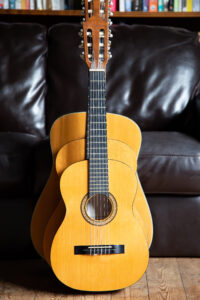 Understanding Acoustic Guitar Sizes: A Musical Puzzle
Understanding Acoustic Guitar Sizes: A Musical Puzzle
Acoustic guitar sizes refer to the dimensions and proportions of the guitar body, which significantly influence the instrument’s tonal characteristics, projection, and playability.
Just like pieces of a musical puzzle, different sizes create distinct voices that cater to various playing styles and preferences.
The Spectrum of Acoustic Guitar Sizes
Acoustic guitars come in several sizes, each with its unique qualities and attributes. Let’s explore some common acoustic guitar sizes and their defining features:
-
-
Parlor Guitar: The parlor guitar is petite and charming, making it an ideal companion for intimate settings.
The name comes from the rooms in which the guitar was typically played in the late 19th century.
Some famous musicians who have been known to use the parlor guitar are, Eric Clapton, Mark Orton, Ed Sheehan, and John Mayer
Its smaller size results in a focused and balanced sound, perfect for fingerpicking and folk music.
-
Concert Guitar: Slightly larger than the parlor guitar, the concert guitar offers enhanced projection and volume. It strikes a balance between portability and sound, making it versatile for various genres.
It is often used in classical music and flamenco music with its full sound.
-
Grand Concert Guitar: With a larger body than the concert guitar, the grand concert guitar boasts a fuller sound and improved tonal complexity.
A popular choice for those who have a smaller stature and require an instrument that’s built to a shorter scale. Great choice for traveling musicians who often play live performances.
It’s suitable for fingerstyle playing and intricate arrangements.
-
Auditorium Guitar: The auditorium guitar, also known as the orchestra model (OM), features a well-rounded sound with a pronounced midrange.
More shallower than the dreadnought and narrower in width than a concert guitar. An Auditorium guitar brings the body closer to the player, making it feel more intimate and comfortable for stage use.
Some famous musicians who play it include Ed Sheeran, John Mayer, and Eric Clapton.
-
Grand Auditorium Guitar: Expanding on the auditorium guitar’s design, the grand auditorium guitar offers a versatile sound profile with enhanced bass response and overall volume.
It is a versatile mid-sized guitar that is a good choice for those who want a single guitar to travel with. The tone is great for strumming and picking. It performs well on stage and in the studio.
It suits a wide range of musical genres.
-
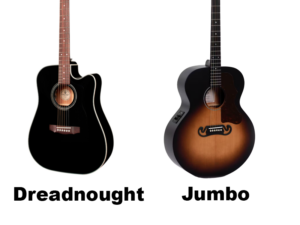 Dreadnought Guitar: The Dreadnought is a true icon, known for its bold and powerful sound. Its large body produces a strong bass response, making it ideal for strumming and vocal accompaniment.
Dreadnought Guitar: The Dreadnought is a true icon, known for its bold and powerful sound. Its large body produces a strong bass response, making it ideal for strumming and vocal accompaniment.This guitar is known for its powerful voice and lower-mid-rich tones that make it a favored choice for country artists. Although it is a popular choice for musicians of all genres.
Some famous musicians who play the dreadnought guitar include Hank Williams Jr, Elvis Presley, Keith Richards, Thom Yorke, and Kurt Cobain.
The original dreadnought guitars were made for the Oliver Ditson Company and featured mahogany backs and sides and spruce tops.
-
Jumbo Guitar: The jumbo guitar lives up to its name with a massive body that delivers robust volume and a deep bass presence.
This is the largest of the guitar family with a deeper body than the popular dreadnought. The body is wider and deeper than traditional acoustic guitars, which gives them a unique appearance.
Jumbo’s are well suited to rhythm guitarists in country and folk rock, and produce a deep rich sound favored by heavy strummers. Some famous musicians who play this guitar are Elvis Presley, George Harrison of the Beatles, Neil Young, Sheryl Crow, and Pete Townshend of The Who.
Choosing the Right Acoustic Guitar Size for You
Selecting the right acoustic guitar size involves considering factors such as playing style, comfort, and tonal preferences. Here are some steps to guide you on your quest:
-
Identify Your Playing Style: Determine whether you lean towards fingerpicking, strumming, or a mix of both. Different sizes excel in different playing styles, so choose one that complements your technique.
-
Consider Body Comfort: Hold and play guitars of various sizes to assess comfort. A guitar that fits well against your body ensures a pleasant playing experience, especially during extended sessions.
-
Evaluate Sound Preferences: Listen to the sound produced by different acoustic guitar sizes. Pay attention to tonal qualities, such as warmth, brightness, and projection, to find the one that resonates with your musical taste.
The Influence of Acoustic Guitar Sizes on Music
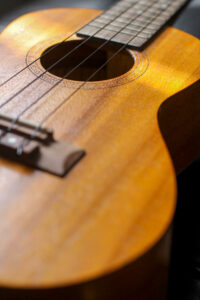 Acoustic guitar sizes and shapes can have a significant impact on the sound of the instrument.
Acoustic guitar sizes and shapes can have a significant impact on the sound of the instrument.The size of the guitar body type also relates to the volume of air within the instrument. Changes to the air capacity of the body will emphasize specific frequencies. A smaller body will have a more focused sound centered on higher frequencies, while a larger body will produce deeper low-end frequencies.
Body dimensions can provide some indication of the tone you might expect, but other factors exert a profound influence, too. Much depends on the tonewoods used to construct the body and the shape, size, and layout of the braces.
Finding Harmony in Acoustic Guitar Sizes
By delving into the nuances of size, sound, and playability, you’ve gained insights that will guide you toward the perfect fit for your musical aspirations.
As you continue your exploration, remember that each acoustic guitar size has its own unique voice and character. Embrace the joy of trying different sizes, celebrate the nuances of their sounds, and let your heart lead you to the one that resonates with your musical soul.
-
Uncategorized
Unveiling the Mystique of the CM Guitar Chord: Your Journey into Harmonic Elegance
Hello, fellow guitar enthusiasts and music aficionados! Are you ready to embark on a melodious journey that introduces you to the enchanting world of the CM guitar chord? Today, we’re delving into the captivating universe of the CM chord – a harmonious gem that adds depth and beauty to your musical repertoire. Whether you’re a budding guitarist eager to expand your chord knowledge or a curious listener seeking to unravel the magic of harmonies, this guide will introduce you to the mesmerizing realm of the “CM Guitar Chord.” So, grab your guitar, find a comfortable spot, and let’s explore the harmonious tapestry of musical expression and creativity!
Unveiling the CM Guitar Chord: A Gateway to Melodic Bliss
Think of the CM chord as a musical key that unlocks a world of melodic possibilities. This chord’s unique tonal quality infuses your music with a sense of warmth and tranquility, making it a versatile choice across various musical genres. Just like a painter selecting colors for a masterpiece, the CM chord allows you to blend notes and create harmonies that resonate with emotion and creativity.
Mastering the CM Guitar Chord: Crafting Harmonic Brilliance
Let’s dive into the mechanics of forming the CM chord on your guitar. Follow these steps:
1. Finger Placement: Begin by placing your index finger on the 1st fret of the B string (the second thinnest string), marking the root note (C).
2. Middle Finger: Position your middle finger on the 2nd fret of the D string (the fourth thickest string), forming the major third (E).
3. Ring Finger: Place your ring finger on the 3rd fret of the A string (the fifth thickest string), creating the perfect fifth (G).
4. Strumming: Focus on strumming the A, D, and G strings (the fifth, fourth, and third thickest strings) while avoiding the low E string (the thickest string) and the high E string (the thinnest string).
5. Sound Check: Strum the strings individually to ensure each note rings out clearly. Adjust finger placement if needed for a resonant sound.
Exploring CM Guitar Chord Variations: Adding Musical Color
While the CM chord is inherently elegant, you can add variations to enhance its sonic palette. Here are a couple of ways to experiment:
1. Add Fingerstyle Patterns: Experiment with fingerstyle picking to create intricate patterns that highlight the individual notes of the CM chord.
2. Change Strumming Patterns: Vary your strumming patterns to add rhythmic interest and dynamic flair to your CM chord progressions.
The CM Guitar Chord in Action: Musical Styles
The CM chord’s warm and tranquil quality makes it a perfect choice for songs that evoke emotions and serenity. Here are a few popular songs that feature the CM chord:
1. “Imagine” by John Lennon: The CM chord contributes to the reflective and contemplative atmosphere of this iconic ballad.
2. “Wonderful Tonight” by Eric Clapton: The CM chord adds a touch of elegance and grace to the song’s tender melody.
Tips for Mastering the CM Guitar Chord
As you embark on your journey to master the CM chord, consider these tips to enhance your playing:
1. Practice Regularly: Dedicate focused practice time to build muscle memory and finger strength for the CM chord.
2. Smooth Chord Transitions: Work on transitioning smoothly between the CM chord and other chords to improve your overall playing fluency.
3. Experiment with Dynamics: Explore playing the CM chord softly and gradually increasing the volume to add dynamics to your playing.
Conclusion: Embrace the Harmony of the CM Guitar Chord
Congratulations, you’ve embarked on a harmonious journey through the enchanting universe of the CM guitar chord. As you strum, experiment with variations, and play songs, you’ll discover the power of this chord to infuse your music with elegance, tranquility, and depth. Keep practicing, keep exploring, and keep embracing the captivating allure of the CM chord. It’s your key to a world of musical expression, where each note resonates with grace and serenity. So, pick up your guitar, let your fingers dance across the strings, and let the harmonious world of the CM guitar chord lead you toward a realm of melodies that soothe the soul and elevate the spirit, one resonant note at a time!
Uncategorized
Guitar vs. Bass: Unveiling the Melodic Battle
In the grand orchestra of musical instruments, few instruments stand as iconic representatives of rhythm and melody like the guitar and bass. These two siblings of strings, each with its distinct voice and role, have woven their way into the fabric of countless compositions, lending depth and character to the world of music. But how do these instruments differ, and what unique contributions do they make to the musical tapestry? Join us as we delve into the harmonious rivalry of guitar vs. bass, exploring their individual characteristics, roles, and the fascinating interplay between them.
The Melodic Duel: Guitar
Versatility and Melodic Mastery: The guitar, with its six strings and fretted fingerboard, emerges as a versatile virtuoso capable of producing a vast array of melodies, harmonies, and rhythms. From the gentle strumming of folk ballads to the blazing solos of rock and metal, the guitar’s melodic potential knows no bounds.
Chords and Harmony: One of the guitar’s defining features is its ability to play chords. Strumming a chord progression can create lush harmonies that underpin the melody, giving songs their distinctive character. The guitar’s wide tonal range allows players to explore various genres, from the twangy notes of country to the complex harmonies of jazz.
Lead and Rhythm: Guitarists often divide their roles between lead and rhythm playing. Lead guitarists captivate audiences with searing solos and intricate melodies that soar above the music. Rhythm guitarists provide the foundation with powerful chord progressions and rhythmic patterns, anchoring the song’s structure.
The Rhythmic Beat: Bass
Groove and Foundation: Enter the bass guitar, the heartbeat of the ensemble. With its deep tones and four strings, the bass guitar occupies a unique rhythmic and harmonic role. While its melodic range may be more limited than the guitar, its impact on the overall sound is profound.
Rhythmic Drive: The bass guitar drives the rhythm and groove of a song, serving as the glue that holds the musical elements together. Its steady pulse and syncopated rhythms lay the foundation upon which other instruments can build.
Harmonic Anchoring: While the bass may not play intricate melodies like the guitar, it provides essential harmonic support. Basslines outline the chord progressions and contribute to the song’s tonal structure, ensuring that the melody and harmony are tightly interwoven.
The Harmonious Interplay
Synergy and Symbiosis: Guitar and bass share a symbiotic relationship, each enhancing the other’s impact. Together, they form a dynamic duo that enriches the musical experience.
Counterpoint and Complement: The interplay between guitar and bass allows for intriguing musical conversations. The bassline’s movement can complement the guitar’s chords, creating an engaging harmonic dialogue that elevates the song’s complexity.
Groove and Texture: The rhythmic groove of the bass provides the backdrop against which the guitar can shine. The guitar’s melodic flourishes enhance the texture of the music, weaving a sonic tapestry that captivates the listener.
Collaboration and Creativity: Whether in a rock band, jazz ensemble, or acoustic duo, guitar and bass players collaborate to shape the sonic landscape. Their ability to work in harmony while showcasing their individual strengths adds depth and dimension to the music.
The Final Chord
In the spirited duel of guitar vs. bass, there is no clear winner, as both instruments contribute their unique voices to the musical chorus. The guitar dazzles with its melodic prowess and harmonic richness, while the bass lays down the rhythmic foundation and harmonic bedrock. Individually, they shine; together, they create a symphonic unity that resonates with depth, emotion, and creativity. Whether you’re strumming a guitar’s delicate melodies or feeling the bass’s pulsating rhythms, the interplay of guitar and bass is a testament to the power of collaboration in the realm of music.
-
advanced9 years ago
How to Play “Sleepwalk” on the 3-String Guitar! Guitar TABs Included!
-
beginner8 years ago
3-String or 4-String? How to Decide Which is Right for You!
-
beginner9 months ago
Exploring Different Guitar Types: A Beginner’s Guide
-
Blues Guitar8 years ago
Go-To Tunings for Blues Slide Guitar
-
advanced9 months ago
Fun and Effective Guitar Exercises: Elevate Your Playing with These 5 Simple Techniques
-
Uncategorized9 months ago
Acoustic Guitar Sizes: Finding Your Perfect Fit
-
Blues Guitar7 years ago
Jack Daniel’s Whiskey Barrel Guitar: How It’s Made and What it Sounds Like
-
Guitars9 months ago
Bass vs Guitar: Exploring the Musical Journey

